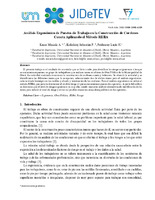Análisis ergonómico del espacio de estudio de un grupo de alumnos de la facultad de ingeniería
Ergonomic analysis of the study space of a group of students of the engineering faculty
Date
2019-10-09Author
Kraus, Micaela Alexandra
Kolodziej, Sebastián Federico
Tarcaya, Héctor Rubén
Posluszny, Lucio Héctor
Jornada de Pesquisa “Salão do Conhecimento : inteligência artificial : a nova fronteira da ciência brasileira” (25 : 20-23 de octubre de 2020: Rio Grande do Sul)
Metadata
Show full item recordAbstract
En el presente trabajo se llevó a cabo un estudio para identificar los riesgos ergonómico, a los que se encuentran expuestos un grupo de estudiantes de la facultad de ingeniería en sus espacios destinados al estudio en sus hogares, dada la situación actual de pandemia. Primeramente, se solicitó a los alumnos que identifiquen y describan los elementos que utiliza para estudiar, la frecuencia de uso de los mismos, para así clasificar la frecuencia a través de una escala (alta, media, baja). Luego, se confeccionó un esquema para cada puesto, indicando la posición de los elementos identificados; se definió el área de trabajo, alcance normal y máximo. A continuación, se llevó a cabo el análisis para determinar el nivel de riesgo ergonómico al que están expuestos los estudiantes, a través del método RULA empleando fotografías para poder definir la posición de los diferentes segmentos corporales para así determinar posibles mejoras. A partir del análisis se determina que el nivel de acción en la mayoría de los casos analizados es de valor dos, lo que conlleva a una actuación que sugiere que pueden requerirse cambios en la tarea, pero, es conveniente profundizar en el estudio. A su vez, existen dos casos de los analizados que presentan un nivel de acción más elevado (de valor tres y cuatro), los cuales requieren de cambios o rediseño del puesto o, en el caso más crítico, se requiere de cambios urgentes en la tarea; esto se debe a que la postura de los estudiantes no es la adecuada y a su vez, por el hecho de que los puestos de estudio no fueron diseñados considerando las dimensiones ergonómicas de cada uno. In the present work, a study was carried out to identify ergonomic risks, to which a group of students from the engineering faculty are exposed in their spaces for study in their homes, given the current pandemic situation.
Firstly, students were asked to identify and describe the elements they use to study, their frequency of use, in order to classify the frequency through a scale (high, medium, low). Then, a scheme was made for each position,indicating the position of the identified elements, the work area, normal and maximum range were defined. Next, the analysis was carried out to determine the level of ergonomic risk to which the students are exposed, through the RULA method using photographs to define the position of the different body segments in order to determine possible improvements. From the analysis, it is determined that the level of action in most of the analyzed cases is of value two, which leads to an action that suggests that changes may be required in the task, but it is convenient to deepen the study. In turn, there are two cases of those analyzed that present a higher level of action (value three and four), which require changes or redesign of the position or, in the most critical case, urgent changes are required in the homework, this is due to the fact that the posture of the students is not adequate and, in turn, due to the fact that the study stations were not designed considering the ergonomic dimensions of each one.
URI
info:eu-repo/semantics/altIdentifier/url/https://publicacoeseventos.unijui.edu.br/index.php/salaoconhecimento/article/view/12020/10696https://hdl.handle.net/20.500.12219/3178
Collections
The following license files are associated with this item:



